Vol. 5 No. 30 TROPIC LIGHTNING NEWS August 10, 1970
Index
The Making of a Kit Carson Scout
By SP4 SCOTT WATSON
CU CHI - During the summer of 1966, a 28 year-old VC squad leader entered a
company of the 9th Marine Regiment, threw down his M-1 rifle and ammunition and
rallied to the side of the South Vietnamese government. But this rallier proved
to be unique - the first of what soon became known as Kit Carson Scouts.
The Kit Carson Scout, whose name derives from that legendary figure of
America's old West, is a member of the North Vietnamese Army or Viet Cong who
has decided to come over to the other side.
Since 1966, the scouts have been proving themselves a valuable aid to U.S.
troops because of their knowledge of the enemy's tactics and familiarity with
the countryside.
According to a division Kit Carson Scout officer, the scouts are recruited
directly from the Chieu Hoi centers. They must meet certain initial
requirements.
"We want them between the ages of 18 and 35 years so that we can be
reasonably sure they will be able to handle the physical side of the job. We
like them to have used some sort of weapon before they rallied because it cuts
down on the hours of training we must give them," he added.
"Also, we prefer those who can read and write. This enables them to learn
and retain more during the training they get before going out to the field.
The final requirement is that they have a valid draft deferment at the time
of hiring. This deferment is supplied by the Chieu Hoi center. "The scout must
not have been released from the center for a period of more than six months," he
said.
The scouts receive several weeks of initial training. The primary emphasis
is on English instruction. Communication is one of the biggest problems scouts
will face in the field.
After the training program has been completed, the scouts are assigned to a
friendly unit where they put their knowledge into practice. How they are used
is left up to the individual unit.
"The Kit Carson Scout out on line is treated like a member of the platoon,"
says Captain David Cogan of Elkhart, Ind., the S-5 for the 2nd Battalion, 27th
Infantry. "They go out on all operations.
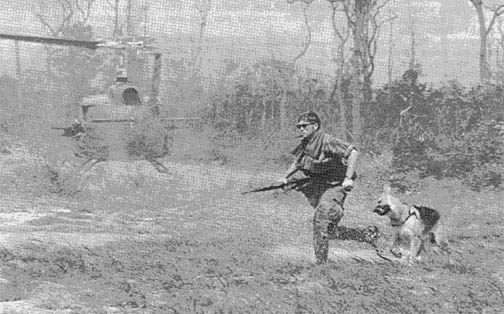 |
| DOWN, DOWN AND AWAY ... Human member of the 2nd of the 12th and friend double time it off landing zone. |
Dreadnaught Tankers Aid Rout of Enemy
FSB LANYARD - Reacting quickly, Dreadnaught tankers supported an element of
the 4th Battalion, 49th ARVN Regiment recently in a daylight operation that
killed 11 NVA soldiers and captured two near the Cambodia border.
Alfa Company, 2nd Battalion, 34th Armor, was conducting a search operation
south of Fire Support Base Lanyard during mid-morning when two artillery
batteries moving north in convoy from Thien Ngon received small arms and rocket
propelled grenade fire.
The artillery units, Bravo Battery, 1st Battalion, 27th Artillery and Charlie
Battery, 2nd Battalion, 32nd Artillery, called for arty, gunship and air strike
support. At the same time the tankers and the ARVN elements moved into the
contact area.
Within 20 minutes, contact with the unknown size enemy element was lost and
the Dreadnaughts and the ARVN began a search of the area. Shortly before noon
they came upon an estimated 150 enemy in a bunker complex.
Artillery and gunship support was again called in for the battle which lasted
90 minutes. With the tankers firing close in support, the Vietnamese troops
killed 11 NVA, took two others prisoner and captured four assault rifles, two
rocket propelled grenade launchers and a light machinegun.
Two ARVN were killed. There were no U.S. casualties.
"It was one of the finest combat maneuvers we've had here," a 1st Brigade
operations officer said. He praised the armor unit for its quick reaction.
The prisoners told officials that the enemy unit's mission was to make
contact with allied forces with special emphasis on ambushing convoys.
Warriors Lay Long-Distance Mech. Ambush
By SP4 ED TOULOUSE
FSB WARRIOR - While the very human Warriors of Bravo Company, 2nd Battalion,
12th Infantry, were humping miles away recently, several mechanical members of
the unit ambushed NVA soldiers just east of Nui Ba Den, killing two.
Meanwhile, two miles to the north, Charlie Company, 2nd of the 12th was busy
destroying a major enemy position.
Actually, the NVA, moving under the cover of darkness, blew their own ambush
when one of the group took a lethal step, tripping several pre-set American
claymore mines.
A mechanical ambush allows American forces to cover areas of known enemy
movement by leaving claymore calling cards behind as they freely move miles
away.
One hang-up with a mechanical ambush is that it can be almost as dangerous
for friendly forces as it is for the enemy. "Disarming one of the devices can
be hairy," said Sergeant John Kukuk of Pontiac, Mich. "Charlie may have
tampered with it."
On the previous day, Charlie Company destroyed two enemy trenches, 21
bunkers, 10 fighting positions and twenty 2.75 inch rockets.
Strike It Rich
By SP4 GREG DUNCAN
CU CHI - While sweeping a late night contact site north of here, 25th
Infantry Division soldiers of Charlie Company, 2nd Battalion, 27th Infantry,
found that they had killed a wealthy North Vietnamese extortionist, who was
carrying $4,400 in piasters and another $1,000 in false bills.
"We had spotted and fired on several enemy soldiers the night before and were
conducting a sweep of the area when we found the body of one NVA," recalled
Staff Sergeant Thomas Curren of Wooster, Ohio. "He apparently had been
surprised while in the middle of a meal, because we found all sorts of food and
cooking utensils nearby. There was a K-54 pistol near his hand. It was
cocked. A round was chambered."
Small Bag
Beside the dead soldier, the GIs found a small bag.
"It was quite a shock to open it up and see all that money looking you in the
face," said Specialist 4 Pat McCarthy of Streamwood, Ill. "When we got back to
our permanent location and began taking a total of everything we had found, it
was unbelievable. Not only had we captured the K-54 pistol, but there were also
numerous articles of clothing and, after counting the money, we figured we must
have had at least $4,000 in piasters. Everyone was pretty excited about the
whole thing," he added.
Paycheck
"We felt that not only had we deprived the enemy of his paycheck, but also
prevented him from acquiring clothes, food, weapons and ammunition," said
Charlie Company Commander Captain Paul Evans from Columbus, Ga.
"The enemy takes this money from the people and then turns around and buys
weapons and ammunition to terrorize these same people. It is like beating him
to death with his own paycheck," Evans said.
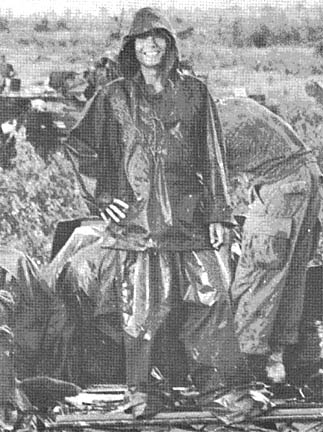 |
FASHION PLATE -- This Kit Carson scout models the latest in monsoon season rain wear. Notice the fine cut of pullover rain smock with hood. Completing the ensemble are bell-bottom trousers made of water repellant material. Wow. |
Page 2 TROPIC LIGHTNING NEWS August 10, 1970
Decorated
| SILVER STAR | |
| SSG Harry A. Courtney, Co A, 2d Bn, 34th Armor | |
|
SOLDIER'S MEDAL |
|
|
CW2 David C. Allen, 25th MP Co CSM August A. Myszka, HHB, 1st Bn, 8th Fld Arty |
SP4 Daniel A. Bruce, HHC, 2d Bn, 14th Inf SP4 Gary W. Watson, HHB, 1st Bn, 8th Fld Arty |
|
BRONZE STAR |
|
|
LTC Albert P. Hodges, HHC, 2d Bn, 34th Armor CPT Philip C. Blake, 2d Bde CPT Flether D. Wilderman, 2d Bde 1LT John Alchus, Co B, 2d Bn, 22d Inf 1LT James L. Kanelakos, Co C, 2d Bn, 12th Inf 1LT Philip E. McMahan, A Trp, 3d Sqdn, 4th Cav 1LT David L. Phillips, Co A, 2d Bn 14th Inf SSG Jerry D. Chinnow, B Btry, 7th Bn, 11th Fld Arty SSG Eddie Demary, Co B, 4th Bn, 23d Inf SSG William H. Hudson Jr, Co B, 2d Bn, 22d Inf SGT Robert Anthony, Co D, 1st Bn, 27th Inf SGT Robert D. Bouscher, Co D, 4th Bn, 23d Inf SGT Thomas J. Cummings, Co C, 4th Bn, 23d Inf SGT Carl R. George, Co E, 3d Bn, 22d Inf SGT Eugene R. Hess, Co C, 4th Bn 9th Inf SGT Steven R. Hudson, Co C, 4th Bn, 23d Inf SGT Paul P. Michael, Co E, 3d Bn,22d Inf SGT Charles E. Ovitt Jr, B Btry, 7th Bn, 11th Fld Arty SGT Eugene R. Powell, B Btry, 7th Bn, 11th Fld Arty SGT Joe E. Roberts, Co C, 4th Bn, 9th Inf SGT Thomas S. Shanaman, Co B, 4th Bn, 23d Inf SGT Clinton M. Spencer, Co B, 2d Bn, 14th Inf SGT Edward Wilson, Co B, 4th Bn, 23d Inf SGT George R. Wood, D Trp, 3d Sqdn, 4th Cav SGT Gregory W. Yahn, Co C, 4th Bn, 9th Inf SP4 Dan W. Childress, Co A, 2d Bn, 14th Inf SP4 Gerald S. Cook, F Co, 75th Inf SP4 Milton E. Cox, Co A, 4th Bn, 9th Inf SP4 Percell H. Daniels, Co C, 4th Bn, 23d Inf SP4 Cleveland H. Egelston, F Co, 75th Inf SP4 Dennis R. Garmoe, B Btry, 7th Bn, 11th Fld Arty |
SP4 James A. Hanson, F Co, 75th Inf SP4 Clarence A. Magwood, Co C, 4th Bn, 23d Inf SP4 Sidney Morrison, Co A, 2d Bn, 14th Inf SP4 Warner Murphy, B Btry, 7th Bn, 11th Fld Arty SP4 Steve E. Odom, B Btry, 7th Bn, 11th Fld Arty SP4 Armond Pinkston, F Co, 75th Inf SP4 James M. Reams, F Co, 75th Inf SP4 James K. Secrest, F Co, 75th Inf SP4 Daniel Simpson, B Btry, 7th Bn, 11th Fld Arty SP4 Mertis L. Snyder Co A, 2d Bn, 14th Inf SP4 J. Michael Swaney, Co A, 2d Bn, 27th Inf SP4 Earnest D. Swiger, Co E, 3d Bn, 22d Inf SP4 Edward A. Tibbs, Co E, 3d Bn, 22d Inf SP4 Allen W. Tonniges, Co A, 4th Bn, 9th Inf PFC Andrew J. Clay, B Btry, 7th Bn, 11th Fld Arty PFC William Foster, Co D, 2d Bn, 22d Inf PFC J. R. Gill, B Btry, 7th Bn, 11th Fld Arty PFC Thomas J. Heavilin, Co B, 2d Bn, 14th Inf PFC Terry L. Holland, B Btry, 7th Bn, 11th Fld Arty PFC Ted D. Hooker, Co C, 4th Bn, 9th Inf PFC Thomas Keller, Co C, 4th Bn, 9th Inf PFC Louis Lesnikowski, Co C, 4th Bn, 9th Inf PFC Leo Lunardi, B Btry, 7th Bn, 11th Fld Arty PFC Sigmund E. Mazur, Co C, 4th Bn, 23d Inf PFC Calrin J. Moffot, B Btry, 7th Bn, 11th Fld Arty PFC Stephen R. Neison, F Co, 75th Inf PFC Carl W. Nichols, Co C, 4th En, 9th Inf PFC Blair D. Rauch, B Btry, 7th Bn, 11th Fld Arty PFC Joseph N. Reyes, Co B, 2d Bn, 22d Inf PFC Arthur B. Rice, F Co, 75th Inf PFC Nelson L. Williams, B Btry, 7th Bn, 11th Fld Arty |
| MESS HALLS No.1 Fire Concern |
By SP4 SCOTT WATSON When thinking of possible places for a fire to break out, one of the first
areas of concern is the mess hall. When thinking of possible places for a fire to break out, one of the first
areas of concern is the mess hall.There are numerous incidents on file of fires that have erupted in mess halls, the majority of which were caused by lack of maintenance of equipment or the failure to take necessary safety precautions. During February of this year, five men were injured, four seriously, when an M-2 field range exploded, throwing gas throughout the kitchen area and causing an estimated $300 damage. The fire was the result of an over-filled cooking pan which was dripping hot grease onto the burner unit, which in turn caught fire. The fire was extinguished. But, because the range was being used without a heat shield, the heat was reflected back onto the fuel cell. As the gas began to heat up, its pressure began to rise but was not detected because the pressure gauge on the unit was faulty. The fire could easily have been prevented if proper maintenance had been pulled on the range, and had the heat shield been in place. Also, the man in charge should have seen that the cooking pan was over filled. It is easy to say what should have been done, but it does little good. If maintenance is kept up and common sense is used before, during and after operation of cooking units, fires can be prevented. Certain areas such as ventilation openings, burner slots and pressure gauges should be checked often to be sure they are not clogged with dirt or rust. All valves should be checked for leaks, as should fuel cells and generators prior to use, to prevent any chance of escaping gasses catching fire. During the operation of the cooking unit, keep an eye on that pressure gauge. If it goes above 20 pounds per square inch, lower the flame until the pressure goes below 20 psi. Afterwards, remember never to refuel the burner while it is hot. A move like that could ruin the whole day. |
| Division Lighters In The Tropic Lightning Association has reported that its list of 25th Division mementos has been expanded once again. Just in are cigarette lighters with the 25th Division "Electric Strawberry" on the front. Still available are division yearbooks, letter openers, wallets, and a record album featuring the division band. |
English Course Slated
CU CHI - The education center here is currently preparing a refresher course
in English for 25th Infantry Division Puerto Rican soldiers who do not speak the
language well. The stated purpose of the program is to "help alleviate existing
communications problems and improve the GI's potential in American society."
The continuing program is a result of a recent conversation here between the
Honorable Luis A. Ferre, governor of Puerto Rico, and Major General Edward Bautz
Jr., Tropic Lightning commander. The Governor pointed out that Puerto Ricans
are sometimes handicapped by the language barrier.
Presently, a letter is being distributed to unit commanders urging them to
inform Puerto Rican soldiers of this opportunity. The program is scheduled to
begin soon.
"Each GI will take a test to determine his fluency in English," said Olin R.
Mc Gill, director of the center. "Indiciduals will be grouped according to
ability and classes will be established," he added.
"We plan on using basic USAFI (United States Armed Forces Institute)
education material, supplemented with Defense Language Institute prepared
tapes," said Specialist 4 Robert Marasa, an ed center staff member.
"Commanders are being encouraged to assign men with greatest need in this
area to the Cu Chi base camp," Mc Gill explained. "This will facilitate access
to the center and the classes. Men in the field will receive taped material and
ed. center staff assistance where possible," he added.
Tropic Lightning Tots
The Commanding General Welcomes
The Following Tropic Lightning Tots
To The 25th Infantry Division – As
Reported By The American Red Cross.
Born To:
| July 16 SP4 Edward Love, 25th Admin Co., boy July 17 SGT Clydell E. Greer, 725th Maint, girl CPT Michael J. Flanagan, HHB 7th Bn, 1 I th Arty, boy |
July 19 PFC Clifford E. Ferrell, HHSB 2nd Bn, 77th Arty, boy SP4 Fred Lowe, Co B 4th Bn, 9th Inf, girl July 20 SP4 Robert Danke, 125th Sig Bn, girl |
The TROPIC LIGHTNING NEWS is an authorized publication of the 25th Infantry Division. It is published weekly for all division units in the Republic of Vietnam by the Information Office, 25th Infantry Division, APO San Francisco 96225. Army News Features, Army Photo Features, Armed Forces Press Service and Armed Forces News Bureau material are used. Views and opinions expressed are not necessarily those of the Department of the Army. Printed in Tokyo, Japan, by Pacific Stars and Stripes.
MG Edward Bautz, Jr . . . . . . Commanding General
MAJ Warren J. Field . . . . . . Information Officer
1LT John Caspari . . . . . . . . . Officer-in-Charge
SP4 William M. Lane . . . . . . Editor
SP4 Scott Watson . . . . . . . . Assistant Editor
SP4 Joseph V. Kocian . . . . . Production Supervisor
BATTALION CORRESPONDENTS
| SGT Mike Keyster SP4 Tom Benn SP4 Frank Salerno PFC Nick Haren SP4 Henry Zukowski PFC Robb Lato SP4 Greg Duncan SP4 Rich Erickson SP4 Ed Toulouse SGT Mike Conroy SP4 Dan Davis |
4/23 7/11 2/22 2/22 2/22 2/27 2/27 2/14 2/12 3/4 Cav 1/27 |
SGT Daniel House SP4 George Graham SP5 Tom Watson SP4 William McGown PFC James Stoup SGT Derr Steadman SP5 Doug Sainsbury SP4 James Duran SGT Jack Strickland SGT Mark Rockney SGT William Zarrett |
4/9 269th 725th Divarty 65th Eng Discom 2/77 3/13 1/27 2/12 4/9 |
Page 3 TROPIC LIGHTNING NEWS August 10, 1970
In 9 Out of 10
The 25th Is Ready
By SP5 TOM WATSON
CU CHI -- The 25th Infantry Division is the number one combat ready unit in
Vietnam, according to a recent USARV maintenance survey.
The figures, for the 3rd quarter of fiscal year 1970, showed the division
statistically ahead in 9 out of 10 "operational readiness" categories.
The operational readiness of the 25th is the responsibility of the 725th
Maintenance Battalion. With its main facilities located at Cu Chi, the
battalion is capable of handling all direct-support maintenance problems that
fall within its jurisdiction. But, in keeping with its motto, "Service To The
Line," the battalion has forward support units attached to each of the
division's three brigades.
These forward companies further aid in the support of line units by sending
out select men in "contact teams." Each contact team has a cross-section of the
company's maintenance capabilities, with the know-how and equipment to solve any
maintenance problem that arises. The contact teams for the most part eliminate
the time-consuming job of removing damaged equipment to the rear.
Staff Sergeant Jackie E. Snyder, of Tell City, Ind., division materiel NCO,
attributed a large part of the 725th's success to these contact teams. He
pointed out that although the battalion is responsible for maintaining more than
twice as many APCs (armored personnel carriers) and tanks as any other division
in Vietnam (excluding the 11th Armored Cavalry Regiment), "it has exceeded the
USARV average for operational readiness in both categories, 97 percent and 93.5
percent respectively."
Even when the maintenance of the division's more delicate and sophisticated
electronic equipment is considered, the 725th keeps the 25th well above all
USARV averages. During the reporting period, the material readiness (in
percentage) of the division's electronic equipment was the highest in Vietnam.
The invaluable radar and night-vision devices approached near perfection with
a 99 percent average of operational readiness for all radar sets and a 97
percent figure for night-vision devices.
Vehicles and generators, the lifeline of supply and power, are an integral
part of any division.
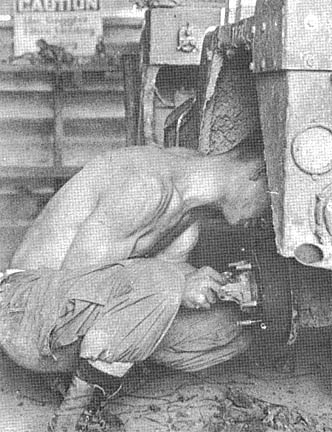 |
KNOCKING OUT CLAY -- That's Cambodian Clay, not Cassius, that Staff Sergeant Charles Morris of El Paso, Tex., is chipping away as he readies the vehicle for the road. |
BETTER IDEA
CU CHI -- The mechanics of HQ and Alfa Company, 725th Maintenance Battalion
have developed a time-saving, money-saving, sweat-saving method of assembling
armored personnel carrier (APC) engines.
In the past, the job required four men, twenty man-hours and an overhead
crane. The engine was lifted from the ground by the crane and while one man
tended the hoister, three worked a feverish five hours apiece repairing the
engine.
But then, one of the men of HQ and Company A -- nobody remembers who -- came
up with the idea of putting the engine, which actually consists of three parts
(engine block, transfer and transmission) on a wheeled stand. The stand was
fabricated in three separate interlocking parts so that the engine could be
broken down or assembled with relative ease.
Cambodian Clay Is Sticky for 1st Bde
By SP4 RICH WERNER
TAY NINH -- The infamous red "Cambodian clay" of Katum, three miles from the
Cambodian border, took its toll on both men and machines of the 25th Division's
1st Brigade. Besides the demoralizing effect of sloshing knee-deep through the
omnipotent ooze, the mud wreaked havoc with the equipment -- especially the four
wheel variety.
After the Lancers returned to Tay Ninh Base Camp, the motor pool mechanics
worked overtime getting their vehicles back into combat-ready condition.
Although no vehicles were completely destroyed during the brigade's stint at
Katum, each one received an unofficial semi-yearly overhaul.
Some jeeps and trucks needed body work because of the mercilessly slippery
mud and some equally merciless drivers. But over all, the major problems were
with engines, where the red stuff had swept into every crack and crevice causing
the mechanics endless headaches and long hours of work.
The Army equipment repair system clerk normally schedules the vehicles for
quarterly and semi annual maintenance. But after Cambodia every vehicle
received a thorough examination, scheduled or not.
The Agony and the Ecstasy
By SP4 ED TOULOUSE
DAU TIENG - The Air Force recently came to the rescue of a 25th Infantry
Division artillery reconnaissance sergeant with Company C, 2nd Battalion, 12th
Infantry. Supply personnel for the up-in-the-sky service were able to solve a
very down-to-earth problem: cramped feet.
During his 16 months of duty in Vietnam, Sergeant Paul Shraeder of Lindenwood,
N.J., has endured the daily agony of maneuvering his size 15 feet into a pair of
size 14 boots.
After a tight squeeze, the boots are made to fit -- but only because Shraeder
is willing to endure a couple of minor inconveniences.
"The only way that I can get the things on is by leaving the laces very loose
and not wearing any socks," Shraeder explained.
Unfortunately for the six-foot, eight-inch recon sergeant, supply systems in
the Army are geared to the more common demands in sizes.
"I've tried to get a pair of 15s for some time," he said. "But, I know from
experience they aren't easy to get." Some concessions must be made by such
Gullivers in a Lilliputian world.
Enter the Air Force. Reading of Shraeder's plight in "Pacific Stars and
Stripes," they pulled off a considerable logistical miracle when they turned up
one pair of size 15 boots, combat tropical, spike resistant.
According to Shraeder, the fit is perfect. But, no matter how you look at
it, he's still got a couple of very big problems.
| IF THE SHOE FITS DEPT. -- Sergeant Paul Shraeder of the 2nd of the 12th shows off new number 15s to much smaller buddy. Now Shraeder can put on socks and tie his shoelaces. |
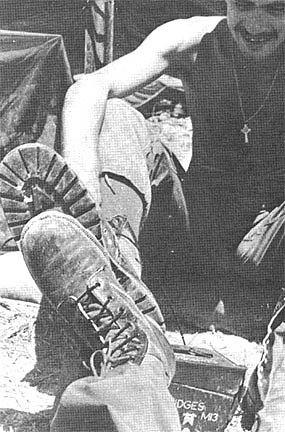 |
A Step To Understanding
By SP4 RICH WERNER
TAY NINH -- English wasn't spoken much in Vietnam before the American
involvement here. French was the foreign tongue most prevalently uttered among
the domestics.
But, every day since GIs began pouring in here, the English language has
played an increasingly important roll in the lives of the Vietnamese people.
Most Vietnamese can speak a sort of pigeon-English, You hear them say "same
same," "number one," "no can do" and "no sweat, GI." But putting the words into
phrases, into sentences, into conversations, is a different thing. English
language classes are scarce and expensive in this land and many persons cannot
afford them.
Sunday Sessions
But, in the shadow of the beautiful Cao Dai Temple, there is a place for
Vietnamese to come and learn English. Each Sunday morning, a group made up
mostly of high school-aged girls and monks comes to the temple and waits
anxiously for a U.S. Army jeep carrying 1st Lieutenant Tom Johnson.
Johnson, from New York City, and now PSYOPS officer for the 1st Brigade, has
volunteered his services to anyone in Tay Ninh City wishing to learn English.
And, the price is right: free.
Since Johnson cannot speak Vietnamese, the language barrier would seem to
destroy any hopes of communication and thus learning. However, the program has
been going on for a couple of years now and Johnson's predecessors laid a solid
working foundation. His students -- numbering as many as 30 a week -- can speak
and understand rudimentary English.
Johnson's main objective is to polish their speaking abilities and to
increase their vocabularies. Anxious to learn and armed with portable tape
recorders, many of the students record the sessions for further study.
Snow on Nui Ba Den
But all is not simple.
"One of the most trying sessions I had was the day I tried to explain to the
Vietnamese what snow is," Johnson recalls. "I spent all morning describing
solid rain that you can roll into a ball and throw at someone. It was
incomprehensible to them."
Johnson, a former English teacher, enjoys his Sunday work immensely.
"It keeps me mentally awake in a place where it is so easy to become
intellectually stagnant," Johnson says.
To show their appreciation for Johnson's help, his students are going to give
him a medal for his meritorious service to the Vietnamese people.
"I don't care about any reward," Johnson says. "I just enjoy teaching." His
greatest reward will probably come on the day when it snows on Nui Ba Den and a
monk from Tay Ninh picks up a handful of the white stuff rolls it into a ball
and throws it at him.
Page 4-5 TROPIC LIGHTNING NEWS August 10, 1970
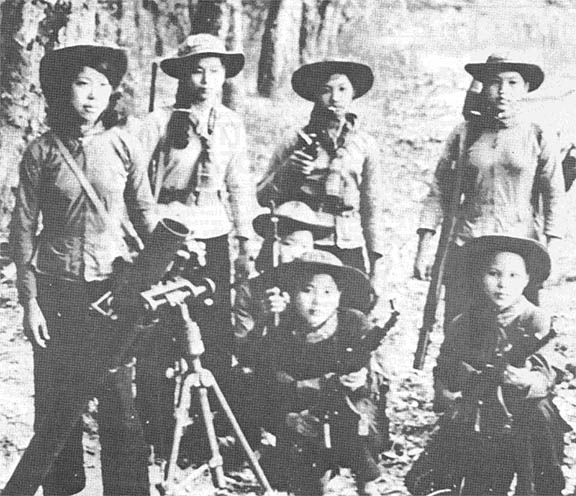 |
| WOMEN TAKE UP ARMS - This photo of a squad of VC (all young girls) was found in a bunker complex near the Razor Back by members of Delta Company, 2nd Battalion, 14th Infantry. In the foreground is an 82mm mortar. One of the girls hefts an RPG (rocket propelled grenade); the others have AK-47s. |
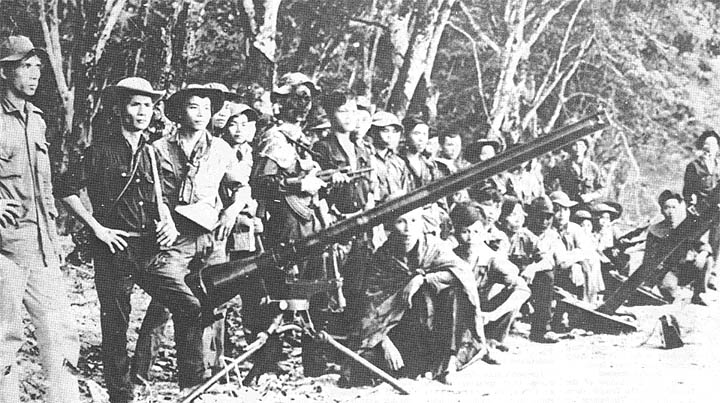 |
| READY FOR BATTLE -- This group of VC came out of the cover of a rubber plantation near Dau Tieng to pose with their big weapons. The heavy guns include a 75mm recoilless rifle and two 82mm mortars. This, along with the other photos, was captured by the Golden Dragons while on a four day bushmaster. |
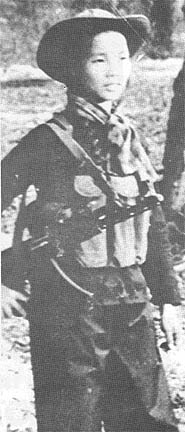 |
Men, Women, Children, Guns: A Portrait of the Enemy |
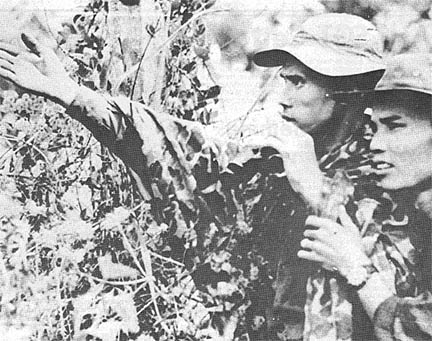 |
| A LITTLE TO THE LEFT -- These two VC appear to be aiming a mortar tube using the line of sight method. They have been operating with a large group of the enemy in the Dan Tieng area. |
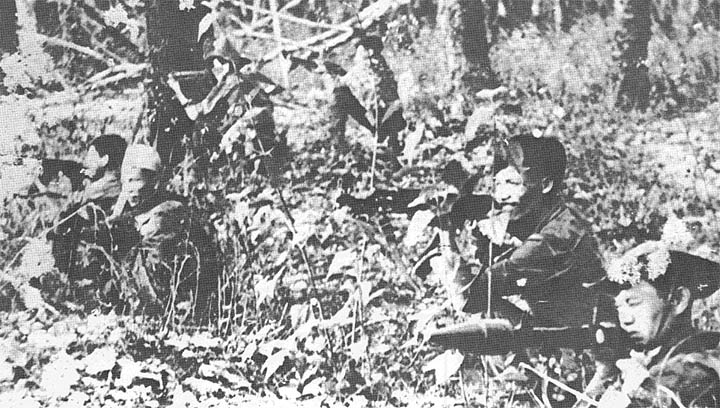 |
| AMBUSH -- It is not known whether this shot was taken during an actual fire fight or if the Viet Cong were just posing for the camera, but they look all business. Most of the VC have AK-47s but the fellow in the lower right hand corner is aiming the feared rocket propelled grenade. |
Page 6 TROPIC LIGHTNING NEWS August 10, 1970
PFC Has Something To Write Home About
From SGT MIKE CONROY
FSB WOOD -- "I never expected to meet a general over here, much less the Army
chief of staff," Private First Class Dana W. Murtz said just after General
William C. Westmoreland had pinned a Silver Star on his chest. "This will
really be something to write home about."
Murtz of Clarkville, Ind., a member of the Second Platoon, C Troop, 3rd
Squadron, 4th Cavalry probably never expected to be in Cambodia in June either.
But what he did there was "really something to write home about."
His unit was performing a routine operation - transporting men from the
squadron laager site to their night defensive position. Suddenly, an enemy
force started throwing an intense barrage of small arms and RPG fire on the
platoon.
From his position, Murtz saw that the entire crew of a nearby Sheridan Tank
had been evacuated. The tank was immobile and in danger of being completely
destroyed. Murtz darted from his position and jumped into the turret of the
empty vehicle. He single-handedly loaded and fired the main gun, forcing the
aggressors farther back into the woodline. He saved the tank and, as his
citation said, contributed immeasurably to the defeat of the enemy.
In addition to the Silver Star, Murtz was selected as the Tropic Lightning
soldier of the week.
It's Happening
(Ed note): "It's Happening" becomes a weekly feature of the division
newspaper with this issue. It's for patting people on the back. It's for
gentle jabs at the foibles and follies of the American fighting machine. The
items included may be funny, informative, worthwhile or totally without
redeeming social importance. If you have an anecdote that you think might be of
interest to your fellow soldiers, tell your brigade correspondent or call the
division information office. Happy Happenings.
WORKING LIKE A MILLION... During the period beginning June 11 and ending July
10, the Cu Chi exchange sold more than one million dollars worth of
merchandise. That's a first. So what, you say. So the PX makes a million
bucks. But that's not the story. What a million dollars in sales means is that
some exchange people have been really humping for the GI, getting the kind of
merchandise he wants and needs. They've been making it available to him here at
Cu Chi and getting it to him out in the field.
"These exchange personnel are really dedicated to their jobs," said 1st
Lieutenant Stephen Norton, a division exchange officer. "They have no
transportation of their own, so they've been borrowing vehicles from the various
support units around Cu Chi to get the stuff up from the Saigon depot. Sergeant
Thomas R. Miller, our liaison man in Saigon, has been making sure we get our
share."
Captain Monte Jochens, Cu Chi exchange officer, and Michael Moreland, retail
manager, have taken extra care to make sure PX items are available for the line
troops.
IF YOU'RE COUNTING ON A DROP, DON'T...It happens every time two or three guys
start talking about home. "I hear they're giving big drops next month. As they
bathe the rumors in beer, the drops grow from a week to 30 days to "I even know
one guy who got a two-month drop." It just ain't so. According to SP4 Robert
Stickelmeier in the port call section at enlisted personnel, there were no drops
in July, will be none in August and who knows about September. As the October
15 deadline for troop withdrawals approaches, there may be some drops ...
perhaps as much as 30 day drops. "But they may just stop sending people over
and let the guys who are already here stay here," Stickelmeier says. So,
whenever the conversation around you turns to getting back to the world early,
drop it.
SEW WHAT ... Army Drill 1, Exercise 24: Electric Strawberry. Ready ... begin.
Hunch your shoulders forward, turn your head to the left and see if you've got
your division patch on your left shoulder. If you do, bingo. However, if you
do this exercise in the States and the results are the same, someone may drop
you for ten. Because, when you return to the world, you've got to switch your
combat area patch to the right shoulder. When you board the Freedom Bird, let
'er rip. Then talk one of the stews into sewing the patch on your right
shoulder. Hint: Uniform should be worn during this procedure.
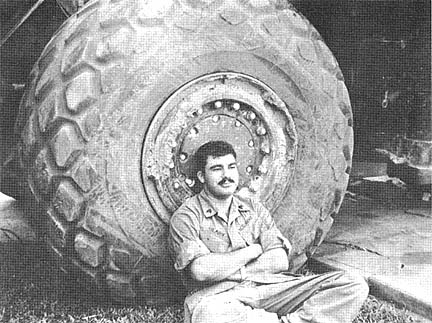 |
BIG WHEEL -- Sergeant Sam Slaiby of Torrington, Conn., S-2 recon sergeant for the 65th Engineer Battalion, relaxes in front of a giant wheel from a crane during corrective construction of the swimming pool at the Waikiki East stand-down area. (Photo by PFC James D. Stoup) |
IG Takes Up Where CO Leaves Off
By SP4 BILL LANE
CU CHI -- You have a problem. You think you should have been promoted and
you weren't. You don't think you have received the proper assignment in
Vietnam. Or you think your platoon sergeant has it in for you. Where do you go
with your complaints? Who can solve your problems?
When George Washington was running the Army at Valley Force during that other
war, he was faced with the same question. He answered it by establishing the
office of the Inspector General.
The IG is here at Cu Chi for two purposes: to act on soldier's complaints and
to assist soldiers in resolving personal problems. If a soldier has a complaint
or a problem, he's urged to first take it up with his unit commander since the
resolution of the problem or the redress of the grievance will probably
eventually fall to him anyway. The CO is the one person who can correct
conditions or circumstances contributing to the situation that is causing the
problem.
A lot of men have been by-passing the chain of command, ignoring the unit
commander and the IG and presenting their problems directly to their
Congressman. This is a constitutional right. However, he'll usually find that
a problem or complaint can be more quickly solved or resolved if presented first
to his unit commander and then to the IG.
Each unit commander opens his door at least once a week for purposes of
letting his men come in to register their complaints.
| Ilikai East by Night WED Floor Show (8 p.m.) THU Birthday Party (8 p.m.) FRI Cook-out & Discussion (8 p.m.) SAT Movie & Popcorn (8 p.m.) SUN Coffee Call (10 a.m.) Tourneys (2 p.m.) MON Banana Splits Sports Night Concentration (8 p.m.) TUE Card Tourney |
Ask Sgt. Certain
Sorry, but you're going to have to go through this week starved for solutions to
your personal problems. Sergeant Certain just went for a burst of six and is
back in the world on special leave. He sent us a post card from Disneyland
(where he is staying) confirming the report that Mickey Mouse is wearing a Spiro
Agnew wristwatch. Speaking of watches, watch for Sergeant Certain next week and
happily ever after.
Page 7 TROPIC LIGHTNING NEWS August 10, 1970
Rubber Plant Links Vietnam with West
By SP4 ED TOULOUSE
DAU TIENG -- To the men of the 25th Infantry Division, the sound of heavy
machinery contrasts sharply with the rural atmosphere they have become familiar
with in the Republic of Vietnam.
Yet, located in Dau Tieng on the Saigon River, a French owned factory, since
1923, has linked this town, and more generally this region, with Western
society.
Today, the mill provides employment for 500 of the town's inhabitants. A
substantial part of the work force is involved in collecting the sap (crude
rubber) from the thousands of trees on the plantation.
Craftsmen at the factory also transform non-productive rubber trees into
furniture used in the company's offices throughout the world.
Along with the free medical care and pensions the mill provides for its
workers, the industry itself is an asset to the economic growth of South
Vietnam.
| LINK TO THE WEST -- The mill at the rubber factory here is a large complex with buildings that bear similarity to those of Western factories. |
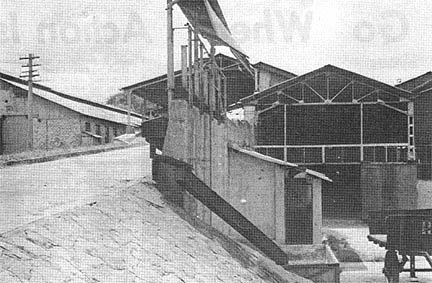 |
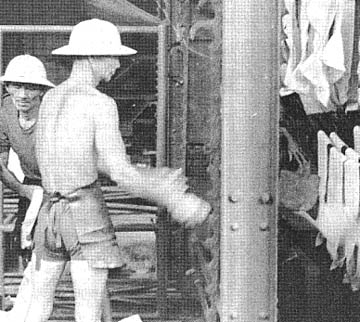 |
KEEPING WITH THE TIMES -- The raw sap of the rubber trees is initially treated in this trough of acid solution where it hardens into strips. The building is one of the many very westernized facilities at the rubber factory in Dau Tieng. |
| FINAL STEP -- The final step in the process of rubber treating involves cutting the latex into strips and hanging it on racks to dry. The rubber factory employs a large percentage of Dau Tieng's employable residents. |
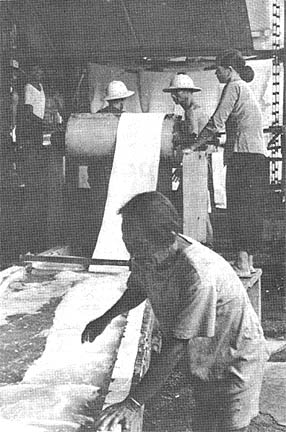 |
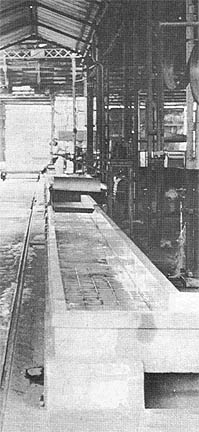 |
FROM SAP TO RUBBER -- At the Dau Tieng branch of the rubber factory, a continuous belt of latex passes through an acid bath (foreground) and then is cut and pressed. |
Page 8 TROPIC LIGHTNING NEWS August 10, 1970
Units of 725th Go Where Action Is
By SP5 TOM WATSON
CU CHI - Whenever a brigade of this Division moves from one area of
operations to another, a forward support unit of the 725th Maintenance Battalion
moves right along with it.
Charlie Company, 725th Maintenance Battalion moved to Xuan Loc with the 2nd
Brigade during the middle of July - lock, stock and barrel. Everything that
Charlie Company needs to perform its mission was carried with them. Repair
parts in every size and shape were crated and loaded in CONEXS and loaded on 5
and 10 ton trailers, which is nothing out of the ordinary day's work for the men
in the 725th.
But, the largest and biggest problem was transporting a 56 ton M-88, VTR (a
recovery vehicle that resembles a Sherman tank). This task was handled with
assurance by the service & evac section of HQ & Co A by loading the VTR on the
bed of a 50 ton "Dragon Wagon." This awesome twosome weighed more than 100 tons
and had to meet the rest of Charlie Company's convoy on the road between Saigon
and Long Binh, since the road that leads directly to Long Binh from Cu Chi is
not equipped with bridges substantial enough to withstand the combined weight.
The convoy moved through the Vietnamese countryside without a hitch, but many
a wary eye peered toward the woodline on both sides of the road because the
convoy made a very pretty target; especially when they had to slow down to allow
the heavier vehicles - such as the VTR - to catch up in the hilly terrain
between Xuan Loc and Long Binh.
The only problem incurred during the entire trip happened after reaching Xuan
Loc. The element of the 199th Light Infantry Brigade which had occupied the
area which Charlie Company was to take over, had not departed at the appointed
time, thus forcing Charlie Company to sit back and relax while the 199th
finished moving to their new area. Not that the men didn't appreciate a chance
to relax after riding more than 85 miles in 4 ½ hours; but, they realized every
minute they were delayed in moving into their new area would be one more minute
they would not get any sleep that night. With darkness rapidly approaching,
Charlie Company was finally able to move into the new area.
The technicians worked at a feverish pace to get vehicles and equipment
unloaded before darkness hampered the operations. The most important vehicle,
as far as the men were concerned, was the one carrying the mess hall equipment,
it was unloaded first and within the hour the mess hall had a snack ready for
the men. Specialist 4 Donald Wagner of Culbentson, Neb., remarked as he wolfed
down a sandwich and Kool-Aid "this is the best damn food I've ever eaten."
The remainder of the night and the next morning were spent unloading the
remaining trailers and supplies necessary to set up an efficient operation.
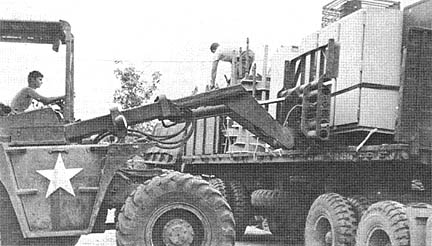 |
CHOW TIME - The mess equipment was the first to be unloaded the day the 725th Maintenance Battalion moved the 2nd Brigade to Xuan Loc. Within half an hour after unloading, there was chow on the table. |
Alfa Company, 2/60 Locates Large Cache
By 1LT BOB GOLDEN
TAY NINH -- Nine American-made M-1 rifles, one Thompson sub-machine gun,
three M-1 carbines, nine Soviet sub-machine guns, eleven German Mausers, 50
Soviet carbines, one French sub-machine gun, two Czechoslovakian light machine
guns and 15 CKCs (Chinese automatic rifles).
The modest beginnings for a museum of international weapons?
Maybe it was, but chances are that Charlie had them earmarked for a few more
battles before putting them on display.
Unfortunately for Charlie, the impressive list of weapons was part of a cache
uncovered by the 25th Division Alfa Company, 2nd Battalion, 60th Infantry, on a
recent operation just a mile southwest of the Vietnam-Cambodia border area known
as the Fish Hook.
In all, the infantrymen collected 104 enemy weapons buried in two old bunkers
deep in the jungles of War Zone C. A 1st Brigade intelligence officer said that
most of the weapons were old and not usable.
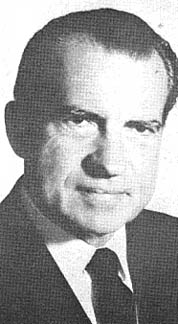 Nixon Lauds Division
Nixon Lauds Division
WASHINGTON - President Richard M. Nixon, in a note to General Creighton W.
Abrams, has extended his congratulations to the members of the 25th Infantry
Division for its conduct of the operations in Cambodia.
"You have my profound gratitude and admiration for the outstanding job you
and your commanders have done in executing the Cambodian sanctuary operations,"
the President said. "I am very proud of the performance of your officers and
men and hope you will convey to them my sincere appreciation and hearty well
done."
Abrams, commander of U.S. forces in Vietnam, in forwarding the President's
comments, asked that his personal congratulations and admiration be convoyed to
all members of this command who participated in the operations.
Lieutenant General Michael S. Davison, commanding general of II Field Force,
also sent along his personal congratulations.
Division Operations
Virtually every element of the division participated in the Cambodian
effort. Most of them physically crossed the border, the rest providing support
from the Vietnam side.
Division units conducted operations inside Cambodian beginning May 6 with
operation Bold Lancer south of the Dog's Face.
MEDCAP's Save Villager
By SP5 DOUG SAINSBURY
TRUNG LAP - There is no such thing as a routine MEDCAP. This truism was
recently demonstrated by the MEDCAP team of the 2d Battalion, 77th Artillery, on
a visit to a hamlet near here.
"It was our first trip to this area and we were in the process of introducing
the people to our program when we heard a commotion several meters away and
noticed a crowd forming," said Private First Class Gary Mitchell from Nashville,
Tenn., a medic in Headquarters and Headquarters Battery. "A woman led us to the
crowd and we found an older woman laying on a wood slab in obvious pain."
"Our interpreter spoke to the people and discovered that the injured woman
had had a headache and to relieve the pain, she had cut large chunks of surface
skin off one of her arms and behind both knees to 'let out the evil blood'," he
said.
"I was shocked at first to hear that these people still use some of those
primitive cures for wounds and diseases, but when I thought about many of these
hamlets being isolated and the lack of exposure to modern medical methods, I
could understand their strange practices," Mitchell recalled.
The Up Tight medics immediately treated the woman's self-inflicted injuries.
Gangrene had appeared in the wounds on the woman's arm and she had lost a lot of
blood.
"I cleansed the wounds, stopped the bleeding, and applied bandages," said
Mitchell. "Her arm was swollen and cold, and her condition was becoming
serious."
After other members of the hamlet were treated and instructed as to the value
of medicine and its proper administration, the woman was taken to the 12th
Evacuation Hospital in Cu Chi by the 2/77th MEDCAP team.
"We were told later that the woman's arm would probably have to be amputated,
but that our treatment might have saved her life," Mitchell said. "It seems
that almost every time we go on a MEDCAP we find an unusual case that needs
immediate attention."
Rallier Leads Bobcats To Bunker Site
FSB SWARTZ -- Two mechanized companies of the 25th Infantry Division rolled
into a mountainous area four miles southwest of Xuan Loc recently and destroyed
24 enemy bunkers after a rallier pinpointed their location for battalion
officials.
The operation began during early morning hours as artillery and an air strike
hit the suspected bunker location. Meanwhile, Alfa and Charlie Companies, 1st
Battalion (Mech), 5th Infantry, were moving into the area from their night
positions.
Alfa Company troopers received enemy sniper fire and suffered one man wounded
as it moved into the first of two complexes at mid-morning. Charlie Company
found one NVA soldier killed by the air strike earlier and destroyed 19 bunkers
in that location.
| LETTING C-RATIONS GO TO HIS HEAD - This rather strangely attired member of Delta Company, 2nd Battalion, 12th Infantry, seems to have his mind set on a big feast. (Photo by SP4 Ed Toulouse) |
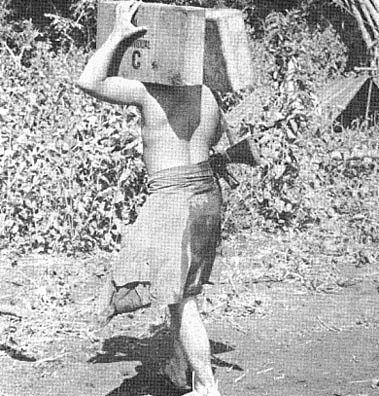 |
Thanks to:
Roger Welt, 4th Bn., 23rd Inf., and a Tropic Lightning News correspondent,
for sharing this issue,
Kirk Ramsey, 2nd Bn., 14th Inf. for creating this page.
This page last modified 08-04-2006
©2006 25th Infantry Division Association. All rights reserved